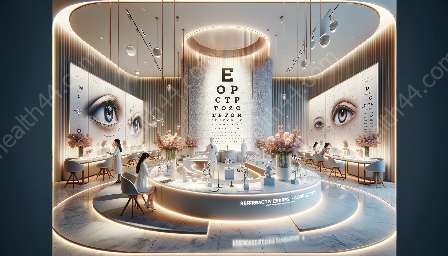Are you looking to improve your vision? Do you want to learn more about refractive errors and how eyeglasses can correct them? In this comprehensive guide, we will explore the world of eyeglasses, vision care, and refractive errors correction. From understanding different types of eyeglasses to how they can improve your overall vision health, this guide covers everything you need to know.
Refractive Errors and Correction
Refractive errors are a common eye condition that affects the way light is focused onto the retina, resulting in blurred vision. The most common types of refractive errors include myopia (nearsightedness), hyperopia (farsightedness), astigmatism, and presbyopia. Fortunately, these refractive errors can be effectively corrected with the use of eyeglasses.
Myopia, or nearsightedness, occurs when the eyeball is too long or the cornea is too curved. This causes light to focus in front of the retina, making it difficult to see distant objects clearly. Eyeglasses for myopia are designed to diverge incoming light to compensate for the excessive convergence caused by the elongated eyeball, thus bringing the focal point back onto the retina.
Hyperopia, or farsightedness, is the opposite of myopia. It occurs when the eyeball is too short or the cornea is too flat, causing light to focus behind the retina. Eyeglasses for hyperopia use lenses to converge incoming light in order to bring the focal point forward onto the retina, allowing for clear vision at both near and far distances.
Astigmatism is a condition where the cornea or lens has an irregular shape, causing distorted or blurred vision at all distances. Eyeglasses for astigmatism have special cylindrical lenses that can compensate for the unequal refraction of light, thus creating a more uniform focus on the retina and improving visual clarity.
Presbyopia is an age-related condition in which the eye's lens loses its flexibility, making it difficult to focus on close objects. Bifocals or progressive lenses are commonly used to correct presbyopia, allowing individuals to see clearly at varying distances by providing different powers of correction in one lens.
Vision Care
Understanding the importance of vision care is crucial for maintaining healthy eyes and overall well-being. Regular eye exams are essential for detecting refractive errors and other eye conditions early on. By visiting an eye care professional, individuals can receive accurate prescriptions for corrective eyeglasses tailored to their specific needs.
In addition to corrective lenses, eyeglasses also play a crucial role in protecting the eyes from harmful ultraviolet (UV) radiation and blue light. Many eyeglasses come with UV protection and blue light filtering technology, which can help reduce the risk of eye strain, digital eye fatigue, and long-term damage caused by UV exposure.
Furthermore, the design and fit of eyeglasses are important considerations for comfort and functionality. With advancements in frame materials, such as lightweight titanium and flexible plastics, eyeglasses offer both durability and comfort for prolonged wear. Additionally, customizable lens options, including anti-glare coatings and photochromic lenses, provide added benefits for varying light conditions and visual comfort.
Types of Eyeglasses
There are various types of eyeglasses available to cater to different vision needs and personal preferences. From traditional frame styles to modern designer frames, the options are vast and diverse.
- Single Vision Lenses: These lenses have a single optical power and are suitable for correcting myopia, hyperopia, or astigmatism at a specific distance, such as near or far vision.
- Bifocal Lenses: Bifocals have two distinct optical powers, typically for near and distance vision, and are commonly used by individuals with presbyopia.
- Progressive Lenses: Also known as no-line bifocals, progressive lenses provide a smooth transition of optical powers for near, intermediate, and distance vision without visible lines, offering a more natural visual experience.
- Photochromic Lenses: These lenses darken when exposed to UV light, providing the convenience of transitioning from clear indoor lenses to tinted outdoor lenses without the need for prescription sunglasses.
- Blue Light Filtering Lenses: These lenses are designed to reduce exposure to harmful blue light emitted from digital screens and artificial lighting, thereby minimizing eye strain and improving sleep quality.
- Sport and Safety Glasses: Specifically designed for sports activities and occupational safety, these glasses offer impact resistance, UV protection, and enhanced visual clarity, catering to active lifestyles and work environments.
When selecting eyeglasses, individuals should consider their lifestyle, occupational requirements, and personal style preferences to find the most suitable and visually appealing options that meet their vision correction needs.
Conclusion
Embracing the world of eyeglasses goes beyond correcting refractive errors; it encompasses a comprehensive approach to vision care and overall visual well-being. By understanding the diverse types of eyeglasses available and how they can effectively correct refractive errors, individuals can make informed choices to enhance their vision and protect their eyes for a lifetime of clear and comfortable seeing.


